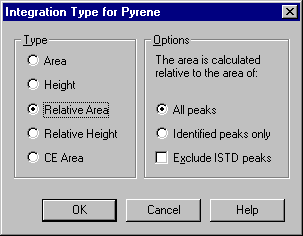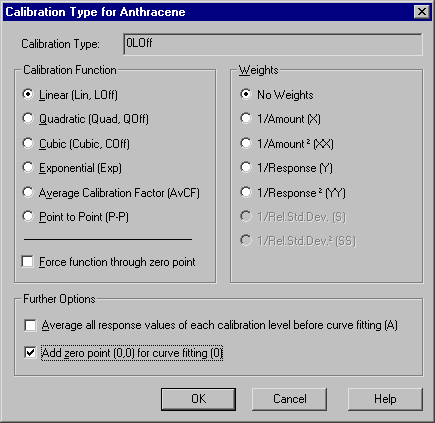Calibrating
![]() Selecting the Calibration Function (Cal.Type and Int. Type Columns)
Selecting the Calibration Function (Cal.Type and Int. Type Columns)
Use the Int. Type (Integration Type) column to define how the individual peaks are evaluated.
Press the F8 key or double-click a cell in the Int. Type column. The following dialog box appears:

In addition to Area, Height, and CE-Area, you can select the relative area or the relative height as the reference for the evaluation (Integration Type).
If you select Area, all amount calculations refer to the area of one peak. This Peak Area Integration is the default setting. The peak height integration is only used in exceptional cases.
![]() Caution:
Caution:
The decision whether it is physically sensible to use a calibration type other than the linear default is the responsibility of the user. (With a calibration type that is physically not sensible, no y values may appear for the actually measured values. For example, if, for the Quadratic calibration type, the calibration function is a bottom-down parabola-shaped curve, the values measured above the summit cannot be evaluated. In this case, Chromeleon reports "n.a.")
The relative height is either calculated relating to all peaks or all identified peaks. ISTD peaks can be considered for the calculation of the total area (height).
There are several peak table columns, which define the conversion of the determined area values into the calculated amount values. A separate calibration and integration type must be assigned to each calibrated peak in the peak table.
Enter a calibration function in the Cal. Type column. Press the F8 key to receive a list of available functions and options. Apart from few exceptions, the calibration types Linear or Linear with Offset are used.

Select an option (here: "Linear"). This function has an offset (LOff). If you want to force the calibration curve through the zero point (Lin), select the "Force function through zero point" check box further down. For calibration types with offset, the origin can be treated as a calibration point, using the Add zero point (0,0) for curve fitting (0) option. In this case, the calibration curve will not be forced through the origin, but the origin will be considered nevertheless.
The Calibration Type determines which Calibration Function is used for deriving a valid amount/area assignment for a larger range from the calibration points of the standard samples. For more information about linear and non-linear calibration types, refer to Theory of Calibration ![]() Calibration Types (Linear), or
Calibration Types (Linear), or ![]() Calibration Types (Non-linear).
Calibration Types (Non-linear).
Usually, all other columns of the peak table can be used with the default settings. Press the F1 key to display more information. Press the F8 key to open an edit box.
Via the calibration type, you can also define the weighting and averaging of calibration values (see How to …: Calibrating ![]() Weighting and Averaging Calibration Points.
Weighting and Averaging Calibration Points.